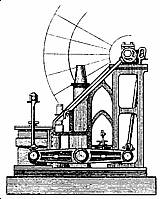

Steamship Curaçao
The first ship to cross the Atlantic Ocean under steam power
1826
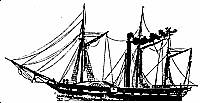
Rijks Stoompacket van Oorlog
Curaçao
Some writers have even gone so far as to express the opinion
that theCuraçaowas a myth!
Francis B.C. Bradlee, The First Steamer to Cross the Atlantic, Salem 1925
Sail versus SteamSteam Records
There has never been such a romantic struggle, in spite of wonderful books like Ernie K. Gann's Twilight of the Gods - and several others.
First, there were sailing vessels; these were equipped with auxiliary steam engines for use in special conditions; as these engines grew better, sail was used less on less on voyages; until, finally, they just didn't bother with it anymore. So Savannah, the first vessel with an auxiliary steam engine to cross the ocean, for the most part did so under sail, and Curaçao was the first to cross, for the most part, under steam.
Sail never really disappeared. The largest vessels to hold out longest were the clippers, transporting grain from Australia to Europe up to W.W.II. Schooner Blue Peter plied the Caribbean Windward Island - Leeward Islands route in the Netherlands Antilles until well after 1950.
Romantics never played any part in jets winning out over props, either.
SS Curaçao — Savannah — Great Western
In 1826, just about the time of the last Captain Horatio Hornblower novel, the Dutch ship Curaçao became the first ship to have crossed the Atlantic, from Holland to Curaçao, under steam power. It was hard to find out more about it, as the literature mostly seems to skip this embarrassing event (just like English maritime history
typically under-reportsthe successful Dutch attack by Admiral Michiel de Ruyter on London. There are other instances). Here is one of the few references I've been able to find.
Riddles galore. The book I found the Curaçao picture in, Oranje en de Zes Caraïbische Parelen, Amsterdam 1948, states that the first trip was in 1827; it opened the first transcontinental regular steam mail service. The voyage from Hellevoetsluis (near Rotterdam) to Paramaribo, Suriname started April 26, 1827 and ended on May 24 (according to others, using the engine for 11 days:
The paddle [sic] had to be changed several times and the boiler was leaking.) The Curaçao conducted three trans-Atlantic passages.
The ship, as drawn by Luitenant ter Zee 1e Klasse C. van der Hart and engraved by W.M. Hoogkamer, looks much more like the Great Western than like the Savannah.

commemoration
TheCuraçaowas originally calledCalpeand was constructed of wood by H.H. and J. Dake, at Dover, England. They sold her to the Dutch Government in November, 1826. She measured 438 tons register [1243m3], 134 feet [40.9m] long; her machinery consisted of "two engines of 50 horse-power (nominal) each."These probably were side-lever engines. From [Paramaribo] she sailed for Curaçao. The return trip begun on July 6th, arriving in Rotterdam on August 4th. In 1828 the
Side-lever steam engine (also here)
The Lore of Ships, Gothenborg 1975.
Curaçaomade a second, and in 1829 a third voyage. She was used as a man-of-war until 1848 [...]
The engines of this truly historic ship were only stopped in case of accidents; on the second trip the machinery worked incessantly from the 1st until the 14th of March. Although a warship, theCuraçaoconveyed private passengers, the mails and valuable freight.
— Francis B.C. Bradlee, The First Steamer to Cross the Atlantic, Salem 1925
In The Advent of Steam, otherwise a fine and interesting book, you will find that Curaçao was a British ship and made only one one-way crossing, like the 1934 Snip flight. While built in England, it was acquired by the Dutch navy.
Confusion still reigns: The Guinness Book of World Records, 1978, states that Curaçao had been built in Dundee, Angus, Scotland in 1826, with a length of 127 foot.
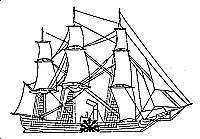
Savannah, 1819
Picture from The Lore of Ships, Gothenborg 1975.
Most sources will tell you that Savannah holds the record, but Savannah, while having a steam engine, was actually powered by sail almost all of the way. Her record is not universally accepted. That was in 1819; to put it in perspective, four years after Napoleon's final defeat and just about when Daguerre took his first snap-shot.
The ship sailed from Savannah, Georgia on May 22, 1819, to arrive in Liverpool on June 20. She had used her engine for less than 80 hours in 27 days (Grolier's Encyclopedia); but for 8 hours in 21 days according to The Oxford Companion to Ships and the Sea. Go figure. From Liverpool she went on to Stockholm and Petersburg, to arrive back in Savannah on November 30, after a voyage of more than six months.
They later removed her engine.
Her 1959 nuclear-powered namesake, a US freighter, was not such a big hit either.

Great Western, 1938
Picture from The Lore of Ships, Gothenborg 1975.
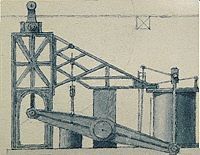 |
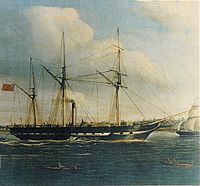 |
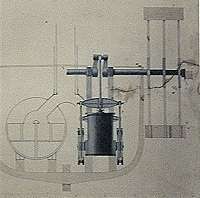 |
The "Prince William" in the Maritime Museum of Halifax, Nova Scotia
with her side-lever engine
another side-lever engine:
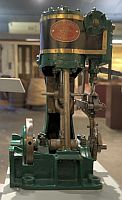
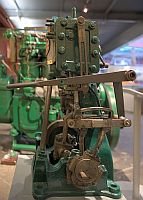
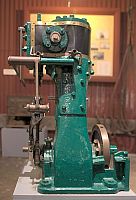
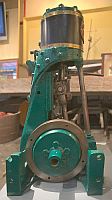
Thwaites Bros, Bradford, York England - Vulcan Iron Works
Maritime Museum, Auckland, New Zealand
The steamship that mostly gets credit for the first Atlantic crossing is the Great Western, in a 1938 race with the Sirius; both used sails as well as steam engines. The Great Western won in 15 days, sailing 4 days after and arriving only a few hours later than her competitor. Indeed, the Sirius was the first to finish the crossing, burning her spars and furniture for fuel en route.
This trip was the beginning of a regular Great Western steam service across the Atlantic, surely a notable occasion. But not the first crossing under steam power alone, as The Columbia Encyclopedia and The Oxford Companion to Ships and the Sea would have it. And not even the first regular steam service for passengers, mail or freight, by any reasonable definition.
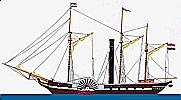
From VB PICTURES
by C.E.A. van Boeckel
setting the steam records straight
1802 Charlotte Dundas Firth of Clyde Canal
1807 Clermont Hudson River
1807 Phoenix Hoboken-Philadelphia
first sea voyage
1819 Savannah Georgia-Liverpool
Atlantic crossing with auxiliary steam engine
1826 - Curaçao - first steam crossing
1830 - first railroad
Liverpool - Manchester
1832 - Rhadamanthus Plymouth-Barbados
claimed first continuous steam crossing
(if not for Curaçao's 2nd crossing)
1833 - Royal William Quebec-London
an earlier age
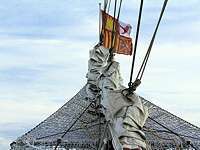
Spanish four-master Elcano
first internal combustion ship engines
1904 Nobel Bros. St. Petersburg, Russia
2 crude oil tankers Caucasia-Wolga River-Black Sea
length 75m - 800 tons cargo - 360 HP engine
1910 Vulcanus Anglo-Saxon Petroleum Co., London
first motor-driven sea ship, built in Amsterdam
1912 Selandia Denmark?
first motor-driven ocean ship
sister ship Jutlandia built by Clydeside shipyard
| Dutch steamships At first sight it may seem strange that the Dutch, with their ship building experience, took so long to switch to steam propulsion. The solution is simple: The development of steam needed coal fuel and iron. The Dutch had neither until early in the 20th century; their Hoogovens blast furnaces were not opened before 1917, processing Indonesian ore, and their first Staatsmijnen coal mines started operating in Limburg, 1906. Holland had been melting iron ore and mining coal for less than a century before both these operations came to an end. So, you might say, did their ship building, except for luxury yachts. |
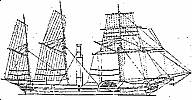
s.s. Curaçao model drawings
available from Modelbouwers
another first
KLM's first Trans-Atlantic
air mail service
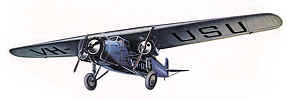
The Christmas flight of the Snip
1934
SEARCH this site or the Web

copyright notice
all material on this site, except where noted
copyright © by , curaçao
reproduction in any form for any purpose is prohibited
without prior consent in writing
